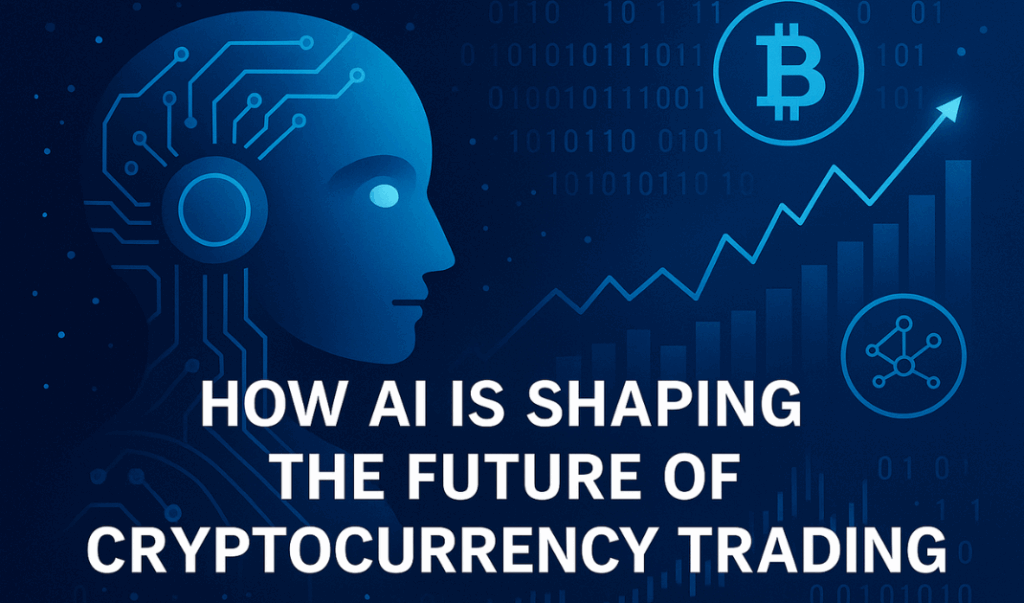With great innovation comes great complexity. Let’s explore how AI Is Shaping the Future of Cryptocurrency Trading, its potential benefits, and the challenges it presents.
In the rapidly evolving world of cryptocurrency, one force is becoming increasingly influential: artificial intelligence (AI). What began as a niche technology is now powering some of the most sophisticated trading tools in the digital finance world. From predictive models to automated bots, AI is changing how traders analyze markets, execute trades, and manage risk.
The Rise of AI-Powered Trading Bots
AI-driven trading bots are becoming a staple in crypto markets. These bots analyze massive amounts of data—including price movements, trading volumes, news headlines, and even social media sentiment—to identify trends and execute trades faster than any human could.
Popular trading bots like 3Commas, Cryptohopper, and TradeSanta use machine learning algorithms to automate trading strategies based on preset rules or adaptive learning models. Some bots also adjust themselves in real-time, learning from previous trades to improve future performance.
Key features of AI trading bots include:
- 24/7 trading — ideal for crypto’s non-stop global markets
- Emotionless decisions — eliminating panic-driven trading
- Backtesting — allowing strategies to be tested on historical data
- Customizable settings — for different risk appetites and trading styles
These bots are especially useful for day traders and swing traders who rely on speed and timing.
Predictive Models: Forecasting the Unpredictable
Cryptocurrency markets are famously volatile. Prices can swing wildly in minutes, making predictions extremely difficult. That’s where AI-based predictive models come in.
By analyzing historical price patterns and real-time indicators like Relative Strength Index (RSI), Moving Averages, and MACD, AI systems can forecast short- and long-term trends. Some advanced models even incorporate natural language processing (NLP) to digest news and social media sentiment for better predictions.
For example:
- ChatGPT-like models can scan thousands of articles and tweets for market-relevant sentiment.
- Time-series models like LSTM (Long Short-Term Memory) networks process price sequences to spot turning points.
- Reinforcement learning algorithms train bots to make decisions based on rewards, mimicking how human traders learn from experience.
These models don’t guarantee profit—but they offer a statistical edge that can improve trade decisions over time.
Benefits of AI in Crypto Trading
AI is bringing numerous advantages to crypto investors:
1. Speed and Efficiency
AI executes trades within milliseconds, seizing opportunities before markets shift. This speed is critical in crypto, where prices can jump or crash instantly.
2. Data-Driven Decisions
With access to global data 24/7, AI can analyze more variables than any human trader. This leads to more informed and less biased decision-making.
3. Personalization
Users can train AI bots to fit specific goals—be it aggressive profit-seeking or conservative, risk-managed growth.
4. Accessibility
Retail traders now have access to tools that were once exclusive to institutional investors, leveling the playing field.
Risks and Challenges to Consider
Despite the upside, AI in trading isn’t foolproof.
❌ Overfitting and False Signals
AI models can sometimes “learn” the wrong patterns from historical data. These errors lead to poor decisions when market conditions change.
❌ High Complexity
Building or customizing advanced AI tools requires technical skill. Misconfiguration can lead to costly mistakes.
❌ Market Manipulation
Some worry that AI bots could be used to exploit low-liquidity markets or execute manipulative strategies like “spoofing.”
❌ Security Risks
Automated bots often require API access to your crypto wallet or exchange account. Without strong security, they can be hacked.
AI and Regulation in Crypto
As AI becomes a core part of trading, regulators are taking notice. Concerns about algorithmic manipulation, financial fairness, and transparency are rising. Governments may soon require stricter disclosures or even licensing for advanced bots, especially in jurisdictions like the U.S. or the EU.
At the same time, some regulators view AI as a tool to monitor market abuse and track suspicious trading behavior.
The Future: Human-AI Collaboration
While AI is powerful, human judgment still matters. The best results often come from combining AI’s speed and accuracy with human intuition and experience. Traders are learning to treat AI as a partner—not a replacement.
In the future, we could see:
- Hybrid trading platforms blending manual and AI trading
- AI co-pilots that assist traders with real-time insights
- Smarter bots that evolve through constant self-learning
These trends suggest AI will not just enhance crypto trading—it will redefine it.
Conclusion
AI is no longer just a buzzword in cryptocurrency circles. It’s a transformative force that’s making crypto trading faster, smarter, and more efficient. From AI-powered bots to predictive analytics, the technology is helping traders gain an edge in an unpredictable market.
But with power comes responsibility. Traders need to understand the tools they use, stay updated on evolving regulations, and never rely solely on automation. In the world of crypto, informed action is the key to sustainable success.
Sources
- CoinDesk. (2025). AI in Crypto: What Traders Need to Know
- Binance Academy. (2025). What Are Crypto Trading Bots?
- Forbes. (2024). AI and Crypto: A Future of Financial Intelligence
Stay Tune TopStoriesKe



